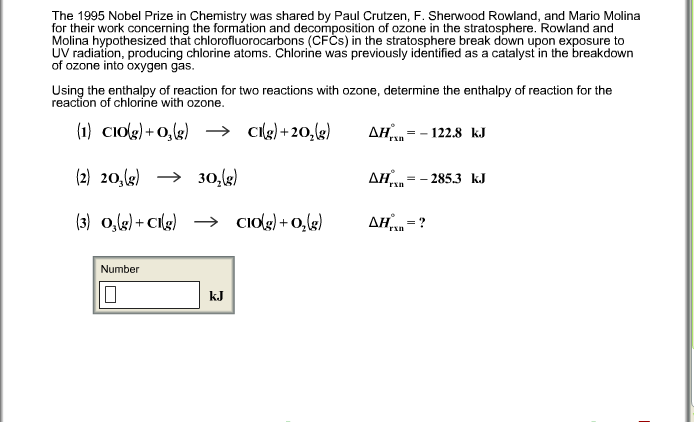The 1995 Nobel Prize in Chemistry was shared by Paul Crutzen, F. Sherwood Rowland, and Mario Molina for their work concerning the formation and decomposition of ozone in the stratosphere. Rowland and Molina hypothesized that chlorofluorocarbons (CFCs) in the stratosphere break down upon exposure to UV radiation, producing chlorine atoms. Chlorine was previously identified as a catalyst in the breakdown of ozone into oxygen gas. Using the enthalpy of reaction for two reactions with ozone, determine the enthalpy of reaction for the reaction of chlorine with ozone. 1) CIOg)+O 3) 03(g)+ C Number kJ
Thermochemistry
Thermochemistry can be considered as a branch of thermodynamics that deals with the connections between warmth, work, and various types of energy, formed because of different synthetic and actual cycles. Thermochemistry describes the energy changes that occur as a result of reactions or chemical changes in a substance.
Exergonic Reaction
The term exergonic is derived from the Greek word in which ‘ergon’ means work and exergonic means ‘work outside’. Exergonic reactions releases work energy. Exergonic reactions are different from exothermic reactions, the one that releases only heat energy during the course of the reaction. So, exothermic reaction is one type of exergonic reaction. Exergonic reaction releases work energy in different forms like heat, light or sound. For example, a glow stick releases light making that an exergonic reaction and not an exothermic reaction since no heat is released. Even endothermic reactions at very high temperature are exergonic.
How do the three reactions relate to each other? Also, how do the given enthalpy values relate to the one that I am supposed to find?

Trending now
This is a popular solution!
Step by step
Solved in 1 steps with 1 images




